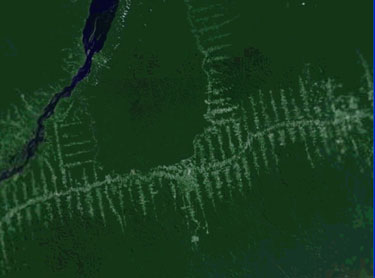Roads are rapidly expanding across the Brazilian Amazon opening up once remote rainforests to loggers, miners, ranchers, farmers, and land speculators, finds a new study published in the journal Regional Environmental Change.
Researchers from Imperial College London and Brazil-based Imazon used maps of existing roads and satellite imagery to track the expansion of the Brazilian Amazon’s road network between 2004 and 2007, a period when nearly 70,000 square kilometers of rainforest was felled in the region. The study found that nearly 17,000 kilometers (10,500 miles) of roads were build annually, amounting to 50,000 km over the period.
The researchers found that roads emerged most quickly in areas with high economic growth and where new settlements were being established.
Study co-author Rob Ewers says the results will be used to help better forecast where deforestation might occur.
 Roads in the Brazilian Amazon. Courtesy of Digital Earth. |
“Knowing where the roads are and the speed at which they are built is key to predicting deforestation,” Ewers said in a statement. “An understanding of road networks is the big missing gap in our ability to predict the future of this region.”
Imazon has already developed a model for predicting deforestation based on the research. The Brazilian NGO announced the model in 2011.
The study also reported that while roads occupy a small surface area, their ecological impact can extend to up to ten times the area due to indirect changes like shifts in temperature and humidity as well as restricting the movement of animals and fragmenting habitat.
Road networks are also outside expanding outside Brazil. A report published last December by the Amazonian Network of Georeferenced Socio-Environmental Information (RAISG), found that the Amazon has nearly 100,000 km of roads, about two-thirds of which are unpaved. 70 percent of those roads are in Brazil, followed by Peru (6.2 percent) and Bolivia (4.5 percent).
CITATION: Sadia E. Ahmed, Carlos M. Souza Jr., Júlia Riberio, Robert M. Ewers. Temporal patterns of road network development in the Brazilian Amazon Regional Environmental Change. October 2013, Volume 13, Issue 5, pp 927-937